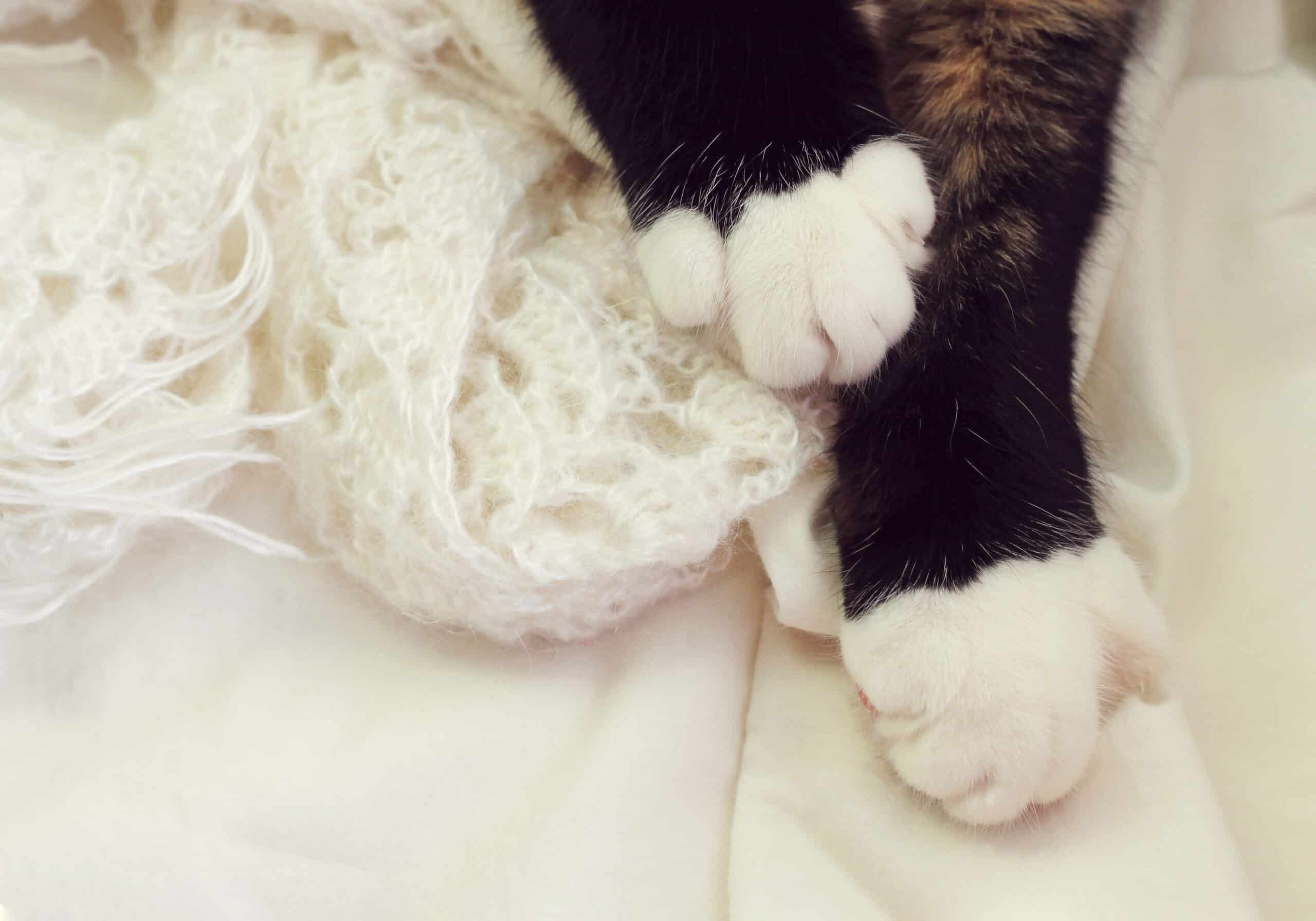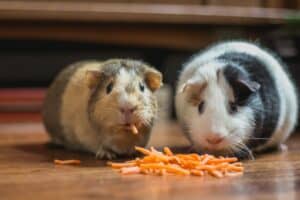| TL;DR: Cats engage in the adorable act of kneading (or making biscuits) for various reasons. Desexed cats make biscuits to spread their scent for communication, to mark property and territory, prepare a place for napping and relive the comforting memory of being breastfed as a kitten. Meanwhile, female cats who haven’t been desexed yet will occasionally lay on their side and knead to communicate that they’re in heat. Generally, kneading shouldn’t be discouraged; you can take steps to minimize your discomfort over your cat’s natural and intuitive behavior. |
If you’re a cat lover — whether you own a darling cat or watch countless hours of kitty videos online — you’ll most certainly have seen a cat hard at work “making biscuits”, a distinctive and easily recognizable cat behavior.
In this article, we’ll look at why your cat has opened its bakery for business, explore the evolutionary background of kneading and learn how you can best encourage this adorable behavior.
Finally, we’ll also find answers to some frequently asked questions about cat kneading. Let’s get into it!
Making Biscuits: Why Do Cats Knead?
Felinology — the delightful field of cat science — is rife with studies that seek to explain the different types of cat behavior. Kneading, the act by which a cat repeatedly uses its paws to apply pressure on a soft object, has also been the subject of scientific inquiry.
Over the years, cat scientists and behavioral specialists have offered several theories to explain the ubiquitous feline kneading behavior.
Here are several of these prevailing explanations:
???? Marking property
When a cat scratches at your expensive couch or your beautiful rug, it spreads scent from its paw glands and marks its property. There is a good chance that kneading is a somewhat less destructive (fortunately) version of this behavior.
???? Getting ready for bed
As kneading often precedes napping, we may then assume that the act could be a way of preparing a surface for maximum kitty comfort. Our cat’s ancestors didn’t have the luxury of pet beds and blankets that the modern feline has nowadays.
Instead, they prepared their own soft places to sleep. Kneading may be an obsolete behavior with the contemporary cat, primarily since the act simulates flattening out the grass or undergrowth to make a bush-craft cat bed.
???? A way to communicate
Domestic cats perform many kitten-like behaviors that their wilder relatives usually outgrow. For instance, meowing is how kittens speak to their mothers, and wild cats typically stop doing that as they mature.
In comparison, domestic cats rarely lose the habit. It has been concluded that meowing in adult cats is reserved for communicating with humans — especially because cats don’t meow at one another.
There is a good chance that kneading is another way that your pet stays young at heart. When adult cats knead, they don’t necessarily long for and attention and care they received as a kitten. Instead, your cat may be kneading because the action allows sorting memory.
???? Kneading as feeding behavior
There is a particular pheromone reason why kneading is a behavior you will typically find among kittens — suckling kittens knead at their mother’s teats to encourage milk flow. When you observe your adult cat kneading, you might even notice it hungrily drooling!
???? Going into heat
If you own a female cat, you might’ve noticed she will become much more affectionate when she goes into heat. One common manifestation of this heightened affection is that she’ll make biscuits more often than usual.
This is because kneading is also a message that female cats send to express that they are in the mood! Have her desexed to prevent your cat from engaging in such undignified displays. Not only will desexing your cat help them live longer, but it will also ensure that any kneading behavior they engage in is purely platonic!
The Evolutionary Background of Kneading
Your cat learns to knead when they are just a tiny kitten; it’s an essential survival skill! When a kitten kneads their mother’s mammary glands, they promote the production and release of milk. Just as when a human breastfeeds her child, the release of breastmilk in cats is an oxytocin-powered reflex.
Oxytocin is a powerful hormone that encourages milk flow and a sense of loving contentment. Given how vital kneading is, it’s unsurprising why kittens engage in the behavior. Kneading also allows a kitten to communicate with its mother via the release of pheromones, which are chemical messages that animals transmit to one another.
The scent glands located in a kitten’s paws release pheromones when it kneads, and the information shared between a mother and her kitten through this method is critical to both animals’ health.
A mother sends messages of comfort and safety to her kittens through pheromones, while a kitten can express hunger or distress to their mother. Similarly, pheromones help kittens find their mother’s teats while allowing the mother to identify her offspring.
As such, kneading is one of the earliest forms of olfactory signaling (talking with smells) a kitten will learn. Olfactory signaling, an essential feline social skill humans often overlook, assists cats in communicating with others and marking their scents.
Eventually, the typical cat kneading behavior develops into “allo-rubbing” — the distinctive feline tendency to rub their cheeks and tails against companions and their property and territory.
What Can You Do About Cat Kneading?
???? Enjoy the moment
Do as little as possible, honestly. Your cat feels safe and content and is possibly reminiscing about its mother’s love and affection. If your cat likes to be petted, this might be a good chance for you to dote on it that way.
If not, try your best not to disturb your sweet kitty when it’s making biscuits. Your cat is feeling very relaxed and happy and you should be honored by how much it trusts you and is comfortable around you.
???? Make yourself comfortable
Kneading is a lovely sign of trust and affection. However, some cats can get a little too into it — some cats convey their enthusiasm by extending their claws and kneading your legs a little too hard.
How do you allow your cat to express this natural and loving behavior without bearing the brunt of its razor-sharp claws?
Here are several options:
- Get a pair of nail clippers for cats — Human or dog clippers won’t do! If your cat will allow you to, trim its claws as preemptive protection. Alternatively, you can invest in cat trees, cardboard scratchers, or hemp rope scratching posts. These products are all dull, shorten the claws of your feline friend and enrich their environment.
- Find a blanket or towel that allows it to express itself without sacrificing your comfort — Remember that your cat isn’t clawing at you maliciously; it’s just gone Kitten Mode and forgotten about the deadly weapons at the end of its toes. Discouraging your cat from kneading would be a rejection of its love. Instead of breaking your cat’s heart,
???? Make your kitty comfortable
Some cats are casual bakers, and others make it a full-time job. If your cat is hardworking, investing in some kitty kitchen supplies is probably time. Buying beds, pillows and blankets for your cat to knead on is an investment in the success of their culinary career. It’s also insurance for your thighs and furniture.
If you encourage your cat to knead on these purpose-purchased items, you can save your couch (and your lap) from a lot of wear and tear. Cats have acute senses and discerning tastes. If you want your cat to use the items you procure, the New York Times suggests that you shop for natural materials such as cotton, wool, or unbleached bedding.
???? Encourage the behavior
You know best what your cat likes. Some kitties want to be stroked and scritched and others prefer a quiet and respectful audience. Whichever category your darling cat falls into, reward its kneading with what it likes.
Frequently Asked Questions about Cat Kneading
???? If kneading is a kitten’s behavior, why is my adult cat still doing it?
Your adult domestic cat isn’t as grown up as you might think; adult domestic cats display many behaviors more typically associated with kittenhood. This is due to a phenomenon that biologists refer to as the “domestication syndrome”. One of the effects of domestication syndrome is the juvenilization of a species.
Because we selectively bred animals to be more prosocial toward humans, domesticated animals tend to look and act more like baby animals when compared to their wilder cousins.
These traits have survived countless generations and are now passed onto modern cats, making your tabby very cute and childish.
???? What does kneading say about how our cats are feeling?
Kneading is a wonderful indication of your cat’s internal sense of safety and contentment.
Whether it’s kneading to express love, to reminisce, or to claim you as its property, your cat is experiencing happiness.
As discussed in this article, it’s best to reward your cats when it engages in kneading.
To minimize the risk of your cat injuring you or damaging furniture, consider providing it with a dedicated blanket to knead upon or a layer to protect your skin when it kneads on your lap.
On the other hand, any cat behavior can be a warning sign if it becomes constant and compulsive. If you’re ever worried about any of your cat’s behaviors, be sure to consult a veterinarian.
???? Why do cats knead blankets?
Cats knead blankets for a variety of reasons which are generally positive.
Most of these reasons have already been discussed previously in this article, but here’s a quick cheat sheet that you can refer to the next time you see your cat engaging in this behavior:
- To spread their scent for communication or to mark property and territory
- To prepare a place for napping
- To express how happy and comfortable it is and how much it loves you
- To relive the comforting memory of breastfeeding as a kitten
- To indicate arousal to potential mates (this is only present in cats that haven’t been desexed yet).
In Conclusion
Kneading or making biscuits is primarily a sign of happiness and comfort in a cat.
If your cat isn’t desexed, kneading may be motivated by its coming into heat — but this unsightly type of kneading is easily avoided by having your cat spayed.
Responsible pet owners will encourage their cats to make biscuits by offering them praise, a suitable environment, natural fiber blankets or unbleached pillows, and anything else that will make their cats happy.
If you see your cat making biscuits, pat yourself on the back. You’ve done a great job as a pet owner and made your feline companion one happy kitty!
| SOURCES Cucala, V. (2023). Practical Feline Behaviour Understanding Cat Behaviour and Improving Welfare. Academia.edu Frank, D. (2001). Feline Obsessive-Compulsive Disorders. vin.com Hazel, S, Henning, J. (2022). Why Do Cats Knead? phys.orgLittle, S.E. (2012). Female Reproduction. ncbi.nlm.nih.gov Mccune, S. (2010). The Domestic Cat. researchgate.net Pet MD. (2020). Why Do Cats Knead? petmd.com Sung, W. (2012). The Physiological Basis Of Breastfeeding. ncbi.nlm.nih.gov |





